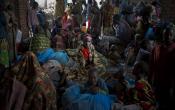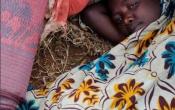Burundi
Operation: Burundi
Location
{"longitude":30,"latitude":-3,"zoom_level":8}
Latest update of camps and office locations 13 Jan 2016. By clicking on the icons on the map, additional information is displayed.
Key Figures
| 2015 end-year results | |
| 8,387 | children were enrolled in primary education |
| 2,887 | households requiring basic and domestic items received relevant support |
| 4,960 | women received sanitary materials |
| 1,200 | people of concern obtained shelter support |
| 2016 planning figures | |
| 12,000 | registered children targeted to be enrolled in primary education |
| 17,500 | people of concern targeted to receive long-term/permanent shelter |
| 3,500 | people of concern to be submitted to resettlement countries |
| 100% | extent to which known SGBV survivors receive appropriate support |
| 100% | extent to which people of concern have access to primary health care |
Latest Updates and Related Links
People of Concern
39%
Decrease in
2015
2015
| 2015 | 84,399 |
| 2014 | 138,111 |
| 2013 | 134,374 |

[["Refugees",53363],["Asylum-seekers",2931],["IDPs",25000],["Returned IDPs",1144],["Returned refugees",14],["Stateless",1302],["Others of concern",645]]
Loading ...
Budgets and Expenditure for Burundi
< Back
2015
{"categories":[2012,2013,2014,2015,2016],"budget":[30.82084694,31.54391216,25.31822673,33.021793127,34.53884162],"expenditure":[23.31374845,22.90897204,20.51341054,15.61407482,null]}
{"categories":[2012,2013,2014,2015,2016],"p1":[28.89418648,30.24224219,23.3993674,18.676158177,28.50049693],"p2":[0.66325324,0.61934524,0.36923053,0.18940178,0.92834469],"p3":[null,null,null,null,null],"p4":[1.26340722,0.68232473,1.5496288,14.15623317,5.11]}
{"categories":[2012,2013,2014,2015,2016],"p1":[21.85597865,21.96405858,18.59464165,14.14254743,null],"p2":[0.47947212,0.52827801,0.36918882,0.13616865,null],"p3":[null,null,null,null,null],"p4":[0.97829768,0.41663545,1.54958007,1.33535874,null]}
Loading ...
CHOOSE A YEAR
- 2014
- 2015
- 2016
Working environment
- In April 2015, sociopolitical tensions affected protection and assistance activities for refugees and asylum-seekers living in Bujumbura. Some 1,500 refugees living in the capital were relocated to Kavumu camp in Ruyigi province.
- Owing to insecurity, non-essential staff were temporarily evacuated to neighbouring countries. Upon their return, they were deployed to field locations while waiting for the situation in Bujumbura to stabilize.
- The restriction of movement has been the main challenge for refugees living in camps.
Population trends
- The number of refugees increased slightly from 52,900 at the end of 2014 to 53,400 people at the end of 2015, despite an unstable political situation. There was a decrease in the number of asylum-seekers from 3,100 in 2014 to 2,900 in 2015.
- The most recent IDP profiling exercise, which took place in 2011, found that some 78,900 people were displaced. A pilot return project, which ended in 2015, enabled 1,100 individuals to benefit from the reintegration programme,leaving some 77,800 persons internally displaced as of end 2015.
- The figure of 1,300 stateless people, mainly of Omani origin, has not changed since the last verification exercise in 2012.
Achievements and impact
- The process of integrating refugee children into the national education system was a major step forward. A plan of action to complete this process was discussed between UNHCR and the Government.
- The cases of over 3,300 individuals were submitted for resettlement in 2015. During the same period, some 1,800 were resettled.
- 2015 saw improvements in the implementation of best interest determination procedures for children, as well as in the monitoring of children at risk. This was achieved in large part due to a strengthened child protection team.
- Refugees had access to 20 litres of water per person per day following the extension of the potable water pipeline.
- An inter-ministerial committee validated two draft bills on the accession to the statelessness conventions.
Unmet needs
- Burundi has signed but not yet ratified the African Union Convention for the Protection and Assistance of Internally Displaced Persons in Africa (Kampala Convention). It was a Party to the 1951 Refugee Convention and its 1967 Protocol, but the Government had not yet removed its reservations on the right to employment, public education and freedom of movement.
- The identification of refugee children with specific needs in urban area remained difficult due to outreach challenges.
- Given that one of the obstacles to local integration was the lack of sustainable income-generating activities, UNHCR started to design a tailored livelihood and self-resilience strategy for refugees in Burundi.





